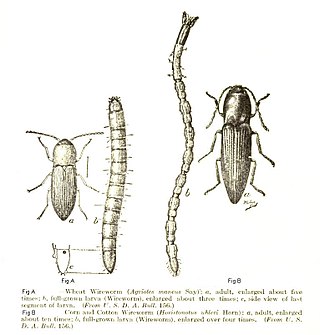
Elateridae or click beetles are a family of beetles. Other names include elaters, snapping beetles, spring beetles or skipjacks. This family was defined by William Elford Leach (1790–1836) in 1815. They are a cosmopolitan beetle family characterized by the unusual click mechanism they possess. There are a few other families of Elateroidea in which a few members have the same mechanism, but most elaterid subfamilies can click. A spine on the prosternum can be snapped into a corresponding notch on the mesosternum, producing a violent "click" that can bounce the beetle into the air. Clicking is mainly used to avoid predation, although it is also useful when the beetle is on its back and needs to right itself. There are about 9300 known species worldwide, and 965 valid species in North America.

The rain beetles are a group of beetles whose extant species are found only in the far west of North America. They spend most of their lives underground, emerging in response to rain or snow, thus the common name. Formerly classified in the Scarabaeidae, they are currently assigned to their own family Pleocomidae, considered the sister group to all the remaining families of Scarabaeoidea. The family contains a single extant genus, Pleocoma, and two extinct genera, Cretocoma, described in 2002 from Late Cretaceous deposits in Mongolia, and Proteroscarabeus of Late Cretaceous China.

Calosoma is a genus of large ground beetles that occur primarily throughout the Northern Hemisphere, and are referred to as caterpillar hunters or caterpillar searchers. Many of the 167 species are largely or entirely black, but some have bright metallic coloration. They produce a foul-smelling spray from glands near the tip of the abdomen. They are recognizable due to their large thorax, which is almost the size of their abdomen and much wider than their head.
Allopeplus cordifer is a species of beetle in the family Cerambycidae, the only species in the genus Allopeplus.
Harpalus cordifer is a species of ground beetle in the subfamily Harpalinae. It was described by Notman in 1919.

Ampedus balteatus is a species of beetle from the family Elateridae and the genus Ampedus.

Oxylamia is a genus of longhorn beetles of the subfamily Lamiinae, containing the following species:
Oxylamia cordifer is a species of beetle in the family Cerambycidae. It was described by Chevrolat in 1856, originally under the genus Monohammus. It is known from the Democratic Republic of the Congo, the Republic of the Congo, Gabon, Nigeria, the Ivory Coast, and Cameroon.
Callimetopus cordifer is a species of beetle in the family Cerambycidae. It was described by Heller in 1924. It is known from the Philippines.

Ampedus pomonae is a species of click beetles native to Europe.

Ampedus pomorum is a species of click beetles native to Europe.

Ampedini is a tribe of click beetles in the family Elateridae. There are about 7 genera and at least 80 described species in Ampedini.
Enoclerus cordifer is a species of checkered beetle in the family Cleridae that occurs in North America.
Neoclytus cordifer, the mangrove borer, is a species of long-horned beetle in the family Cerambycidae.

Parham Park SSSI is a 263.3-hectare (651-acre) biological Site of Special Scientific Interest in the grounds of Parham Park, west of Storrington in West Sussex. It is a Nature Conservation Review site, Grade 2.

Ampedus is a genus of click beetles in the family Elateridae. There are currently 461 recognized species of Ampedus beetles. It has a cosmopolitan distribution, but is found mostly in the Holarctic region, primarily in North America, Europe, and Asia. The oldest known fossil from this genus was found in Eocene Baltic amber, estimated to be from 38.0 to 33.9 million years ago.









